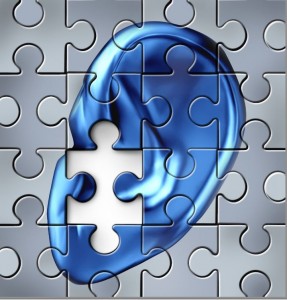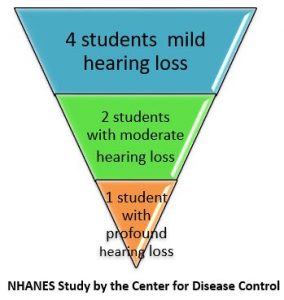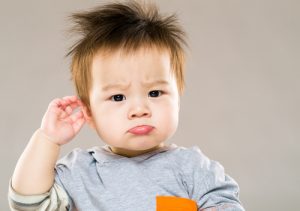Related Products
For Professionals
- Amplification
- Assessment of Student Skills, Challenges, Needs
- Early Childhood: Infants, Toddlers, Preschool
- Hearing Loss – Identification, Impact and Next Steps
- IDEA Law Summary Information
- Language and Speech Development Issues
- Legal Issues in Serving Children with Hearing Loss
- Listening (Auditory Skills) Development
- Planning to Meet Student Needs
- Self-Advocacy Skills for Students with Hearing Loss
- Self-Concept: How the Child with Hearing Loss Sees Himself
- Social Skills
- Speech Perception & Learning
Related Teacher Tools Takeout Items
Hearing Loss – Identification, Impact and Next Steps
Hearing and listening are the cornerstones for learning for almost all children. If a child cannot clearly hear or attend to spoken information, speech and learning spoken language will likely be impacted. This means that hearing loss can cause learning challenges related to academic achievement, communication difficulties, and potentially result in social isolation, poor self-concept and even have an impact on eventual vocational choices.
>The early identification of hearing loss and early intervention services work to minimize these adverse effects by providing improved access to verbal and/or visual language. Parents who learn about their child’s hearing loss and how to talk about it with the child and others, will have a positive impact on their child’s self-image and growth.
Research has indicated that indicated five out of every 1,000 children are impacted by hearing loss. Children may be born with hearing loss or may acquire hearing loss after birth from illness, trauma, ototoxic medications, noise exposure and genetic factors1. The earlier hearing loss is identified the earlier interventions can begin. While most states and provinces in North America now identify hearing loss at birth through newborn hearing screening programs, there remain hearing losses that may not be identified at birth that require assessment by an audiologist to determine the type and degree of hearing loss.
While it is considered to be a “low incidence” disability, hearing loss still affects a large number of children in the school systems who are trying to listen and learn through auditory systems that are not equal to that of their peers. Listening and learning with a hearing loss comes with challenges and as a result, children with hearing loss may face both educational and social-emotional barriers.
In addition, 30-40% of children with hearing loss have additional learning issues. Learning about these potential difficulties will prepare you and your child for their journey through childhood and beyond.
It is often overwhelming for parents to be told that their child has a hearing loss. There is often a period of grief, loss and uncertainty (“what does this mean for my child?”) followed by a learning curve as parents navigate health and education systems, learning how to best advocate for their child.
Each child needs their parents to move forward, one step at a time. With early diagnosis, appropriate technology, good language models and the unconditional love and support of the family, the child will have the opportunity to fulfill their potential.
Identifying a Hearing Loss: This section provides information about identifying hearing loss from birth, hearing loss in young children due to ear infections and identifying hearing loss in school-aged children.
Next Steps After Screening What should happen after a child has failed a hearing screening? What if they are actually diagnosed with a hearing loss? What are the next steps? This section explores what to expect once the child has failed a hearing screening or that child has been found to have a hearing loss.
Types of Hearing Loss This section provides information about normal hearing sensitivity, the causes and different types/degrees of hearing loss, and related options for improving the outcomes of the child so development can be as typical as possible.
Hearing Loss Plus – additional disabilities 30-40% of all children with hearing loss have one or more additional disabilities. Read here for more information on understanding hearing loss plus.
The Impact of Hearing Loss Because hearing loss is invisible, it is hard to really understand just how much it can affect a child’s day-to-day life and lifelong potential. This section provides information about how hearing loss can impact listening/learning and social-emotional growth.
Describing Hearing Loss to Teachers and Peers Children who have a hearing loss are at educational and social-emotional risk. Parents, teachers, audiologists and other professionals should work together with the child, to understand the hearing loss and to advocate for their listening needs. This section provides resources about how to explain the impact of hearing loss to teachers and peers.
Frequently Asked Questions about Hearing Loss Read here for answers to some common questions regarding hearing loss.
Hearing Loss Identification “Does my child have a hearing loss?”
 Hearing loss is invisible – it is not always apparent that a child is having hearing difficulties. US Hospitals routinely perform hearing screening on infants in the first 24-48 hours after birth. If an infant fails the initial screening, he or she is usually scheduled for a second screening a few weeks later. However, sometimes infants who pass the hearing screening at birth may exhibit signs of hearing loss as they age.
Hearing loss is invisible – it is not always apparent that a child is having hearing difficulties. US Hospitals routinely perform hearing screening on infants in the first 24-48 hours after birth. If an infant fails the initial screening, he or she is usually scheduled for a second screening a few weeks later. However, sometimes infants who pass the hearing screening at birth may exhibit signs of hearing loss as they age.
Hearing loss may be identified at birth or any time thereafter. If there are any concerns regarding a child’s ability to hear (at home or school) do not hesitate to have their hearing tested. It is never a waste of time for an audiologist to report that a child has normal hearing.
 The Hearing Loss Identification and Next Steps section provides background into what to consider if you’ve found out your child may have a hearing loss. Under the Hearing Loss Identification section you will also find pages on:
The Hearing Loss Identification and Next Steps section provides background into what to consider if you’ve found out your child may have a hearing loss. Under the Hearing Loss Identification section you will also find pages on:
- Hearing Loss Identification and Diagnosis
- Hearing Screening Resources
- He Failed Hearing Screening! What’s Next?
- Questions Families Often Ask About their Child with Hearing Loss
There are different types of hearing loss.
 Hearing Loss – Information on Specific Types
Hearing Loss – Information on Specific Types
- What is ‘normal’ hearing for children?
- Relationship of Hearing Loss to Listening and Learning
- Auditory Neuropathy Dyssynchrony Spectrum Disorder (ANSD)
- Ear Infections and Learning
- Hearing Loss Caused by Noise
- Hyperacusis – Over-sensitivity to sound
- Mild Hearing Loss and Learning
- Permanent Conductive Hearing Loss – Atresia, Microtia, Etc.
- Unilateral Hearing Loss – hearing loss in only one ear
 About 30-40% of children with hearing loss have additional learning issues
About 30-40% of children with hearing loss have additional learning issues
Hearing Loss PLUS Additional Disability(ies)
Because hearing loss is invisible, it is hard to really understand just how much it can effect a child’s day-to-day life and lifelong potential.
 Rather like trying to describe a new color of the rainbow that is not visible to most people, it is challenging to describe the affects and potential impact of hearing loss. Describing the IMPACT of hearing loss. Go to this page for a list of many simulation audio and video materials that assist in understanding how hearing loss truly can impact listening, development, access to instruction, socialization and overall learning.
Rather like trying to describe a new color of the rainbow that is not visible to most people, it is challenging to describe the affects and potential impact of hearing loss. Describing the IMPACT of hearing loss. Go to this page for a list of many simulation audio and video materials that assist in understanding how hearing loss truly can impact listening, development, access to instruction, socialization and overall learning.
- Demonstrations: Simulations of Listening with Hearing Loss and Hearing Devices
- Relationship of Hearing Loss to Listening and Learning – handouts on 9 hearing loss levels
- Inservicing the Classroom Teacher
- Understanding Your Student’s Hearing Using the Desired Sensation Level Approach
Revised March 2017. Our sincere thanks to Krista Yuskow for her contributions to this content.

